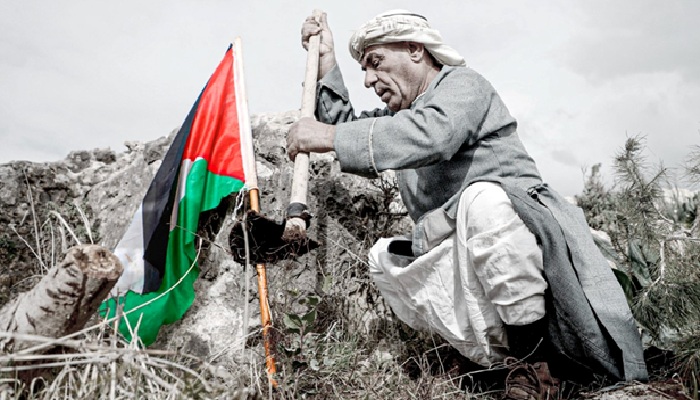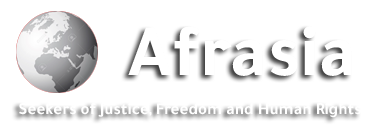
Afrasianet - Author: Richard Morgan - Despite the peculiarity of the word "steadfastness" for Palestinians, it reveals universal realities.
The American magazine "Foreign Policy" publishes an article that addresses the concept of Palestinian "steadfastness" as a cultural and human idea and essence that transcends geography and politics to become a global symbol of resistance, dignity and determination to exist.
The following is the text of the article translated into Arabic:
On my first trip to Palestine as an adult, I visited the Church of the Nativity in Bethlehem, where I was attracted by a large painted wooden statue of St. Georges killing a dragon. According to the inscription on its base, it was a gift from the city's ancient Dabdoub family, my mother's family, who had lived in Bethlehem since the Crusades. When I asked my Palestinian guide why the statue was there, he shrugged his shoulders and replied in one word in Arabic: "Steadfastness".
St. Girgis is considered a hero among the Palestinians, and one of Bethlehem's sculptors described him as "a knight full of peace and grace, on his horse always fighting evil." The word "steadfastness" often means patience and perseverance, while it is misunderstood by Israelis as "clinging to the ground," rather than as a conscience overflowing with boldness and dignity.
Palestinians call their children "steadfastness." But no one proclaims to be steadfast, but is referred to by others as an example of boldness and courage. Resilience is something constant and invincible strength, and it kills dragons like St. Georges.
Arabic is spoken by some 400 million people in about 30 local dialects, but "steadfastness" has been a special Palestinian term since 1978, when the Palestine Liberation Organization (PLO) adopted resilience as a mechanism to cope with the trauma of life under Israeli occupation. The word gained international recognition recently, when the Global Steadfastness, led by civilians, set sail from Europe from Europe to try to break Israel's blockade of Gaza.
Italy and Spain have sent warships to protect the flotilla, while leaders from Colombia, Malaysia, South Africa and Turkey condemned Israel's military interception of the flotilla earlier this month. Raja Shehadeh, founder of the Palestinian human rights organization Al-Haq, describes resilience as "watching your house turn into a prison, choosing to stay in this prison because it's your home, and because you're afraid that if you leave, your jailer won't let you go back."
Shehadeh wrote in his magazine "The Third Way" that if you live this way, you must "constantly resist the temptation between being satisfied with the jailer's plan in idle despair, or madness due to consumed hatred towards the jailer and yourself."
A common understanding of the concept of steadfastness in the West is the way Palestinians face repressive measures by Israeli officials against displaying the Palestinian flag, while many now celebrate watermelon for its naturally occurring black, green, red, and white colors, the colors of the Palestinian flag. It's a kind of clever resistance in the age of social media, where watermelon has become the most popular Palestinian flag emoji without the ability to ban it.
Resilience is how a Palestinian refugee camp, known as the world's most exposed place to tear gas, is transforming a place to make jewellery out of gas canisters for a gift shop. It is the epic dream of the West Bank city of Rawabi, the first planned city in Palestine, and it is Hanzala for a 10-year-old refugee who has turned his back on the world since 1973. It is the determination of the children in the West Bank to see the sea, the children who make up half of the Palestinian population, living in the midst of genocide, where every Palestinian birth is an act of steadfastness.
Resilience is also Hussam Zomlot, who was born in a refugee camp in Rafah and became Palestine's ambassador to the United States and then the United Kingdom. Resilience is the vision of Palestinian tech startups, the journalists in Gaza, each of whom records his will before the Israeli bombs reach him. Resilience was inadvertently captured by the heart of the world last March during a lavish group breakfast in the rubble of Gaza.
This summer, Israeli Minister Itamar Ben-Gvir posted a 13-second video in which he is seen mocking Marwan Barghouti, the Palestinian political leader who has been in prison for 20 years. Barghouti's wife, Fadwa, scanned the video for one frame she believes shows her husband's strength, and asked his supporters to use that photo to publish the details of this encounter, which is Steadfastness.
Wherever there are Palestinians, there is always steadfastness. Others may argue that Palestinian identity is known as the Nakba, the Arabic word for catastrophe, which is used to refer to the mass slaughter and displacement of Palestinians when Israel was founded in 1948. But the darkest hours of a people are rarely at the center of their heritage; Palestinians are accustomed to being misunderstood by others, especially by stereotypes that portray them as terrorists by force, rather than as the reality of their struggle against terrorism and their resistance to Israeli occupation and genocide through steadfastness. Many people who call Palestinians terrorists are not afraid of their weapons, but of their very existence, and of the pulse of the Palestinian who beats like a revealing heart in light of Israel's attempts to cover Palestine with paper.
In this interconnected age, the term "resilience" is spreading online and is available to everyone. It appears in the names of outreach programs in American churches, in a clothing label selling Che Guevara jackets, on a Finnish shopping bag, in the lyrics of British songs, and in a nonprofit perfume sold in Oregon.
It's fair to say that the world is full of misused foreign concepts such as "aloha", "la brega", "dwendy", "hige", "ikigai", "jogad". Unstudied cultural exchange is also prevalent in the West, where people buy fake sympathy with keffiyeh scarves on catwalks, pretend to pronounce letters, or get dubious Chinese tattoos.
Despite its Palestinian specificity, "Resilience" reveals universal realities. The United States and Palestine may seem like two contradictory worlds: land of opportunity versus land of occupation. But resilience is no stranger to American history: American resilience is found in the Chinese poetry engraved on the walls of Angel Island in San Francisco Bay, in Emmett Till's mother who demanded an open coffin, or in First Lady Jacqueline Kennedy, who refused to change her pink chanel suit and reportedly said, "Let them see what they did," in an unintentional definition of resilience.
American Resilience is a small hotel around the Civil Rights Museum in Memphis, Tennessee, and is named after the Vietnam Veterans Memorial. It is a Puerto Rican flag draped in the shape of a scarf on the crown of the Statue of Liberty, and the absence of the September 11 Memorial. It's the shoe collection of any Holocaust museum, painting and repainting the rainbow-colored sidewalks in Orlando, Florida. American Resilience knows that revolutions don't start with chants, marches, or even riots. It begins with the sacred silence of the students sitting at the lunch table in Greensboro, North Carolina, or with a 42-year-old seamstress sitting in a bus seat in Montgomery, Alabama.
Mohsen Mahdawi, a Palestinian student who recently returned to Columbia University after being arrested for his activism last month, says, "My resistance is not about running away. It's easier to distance myself and go somewhere else, but my choice is to stay to be part of the solution, part of the resistance, and who envisions what the future will look like."
In this historic year of global support for the Palestinians, U.S. sympathy for Israel has fallen below 46 percent for the first time in 25 years, since Gallup began conducting this poll annually. Sympathy for Palestine has reached an all-time high of 33 percent.This shift is largely due to Americans' dissatisfaction with Israel's brutality in Gaza, which is now opposed by 60 percent of the American public, according to a separate Gallup poll as well.
Jewish Americans view Israeli violence and war crimes very negatively, while the international community understands the meaning of resilience in the sight of the "tank man" moving left and right alone in the face of the Chinese army in Tiananmen Square, the million-mile odometer in an old Chevrolet newly painted pastel-colored Chevrolet in Havana, or the shadows of humans burned in stone, known as the "Hitokagi no Ish" at the Hiroshima Memorial Peace Museum.
Resilience is neither a burden nor a stigma for a people. Humans have shared the instinct for resilience since their cave days, when they left their fingerprints on the walls. It was not an expression of vanity, as archaeologists have recently discovered that these fingerprints may actually have been testimonies of life, community, and shared joy.
We have come a long way since those caves, but not as much as we like to think. Resilience is an eternal reminder of the disadvantaged, and of how easily people abuse those disadvantaged. It is a condemnation of Israel's brutality, of the U.S. government that funds it, and of the wider world that is watching with a reaction that is nothing more than a finger-waving reaction.
Yet the disenfranchised Palestinians refuse to be non-existent, they are the alchemists of life who turn heavy deprivation into Oscar gold. This is steadfastness: an unapologetic possession of the knowledge that human existence itself carries a power that brute force or cowardly cruelty cannot touch. If the United States is the melting pot of the world, Palestine is the world's millennium, where human beings are crushed and grinded, and all that remains is steadfastness.
• Source: Foreign Policy magazine

